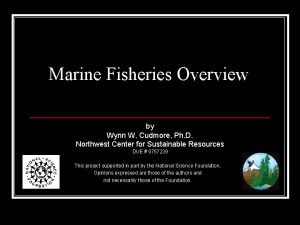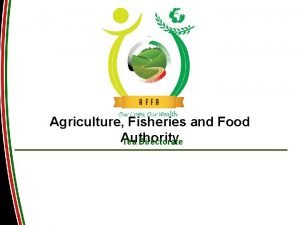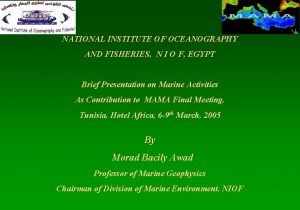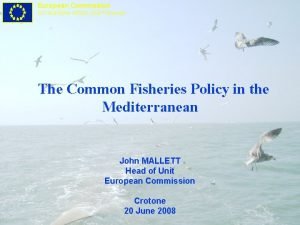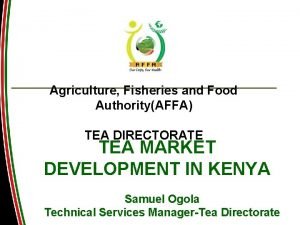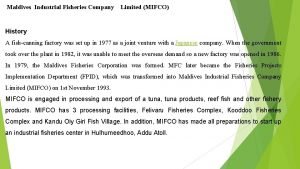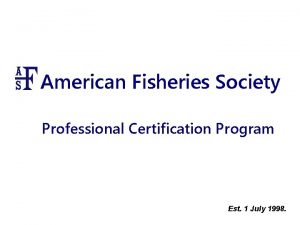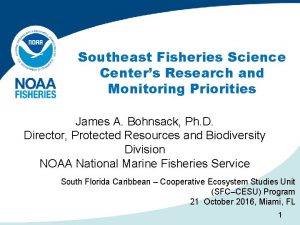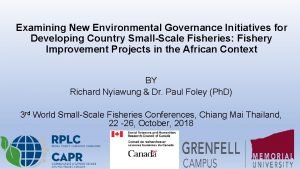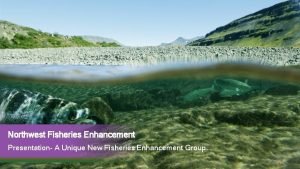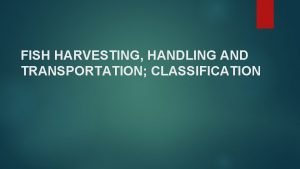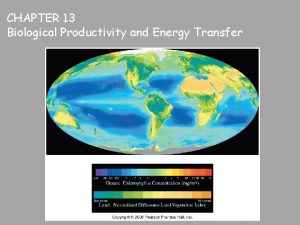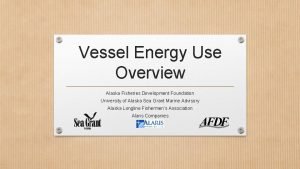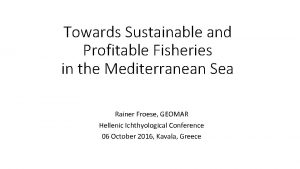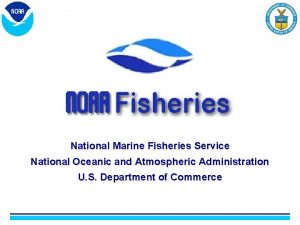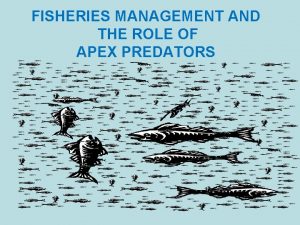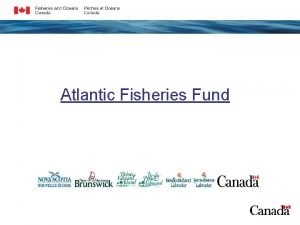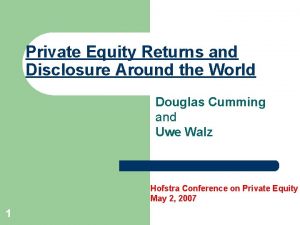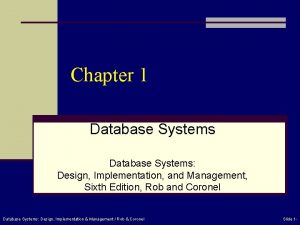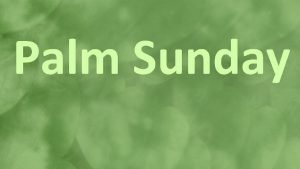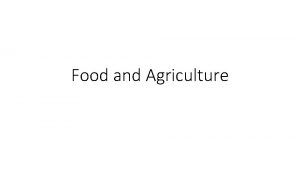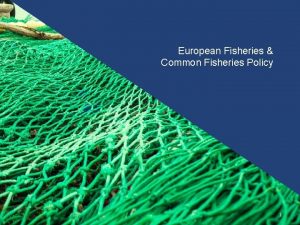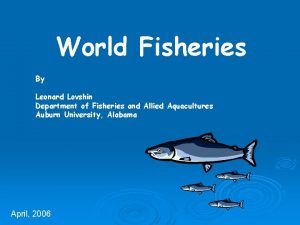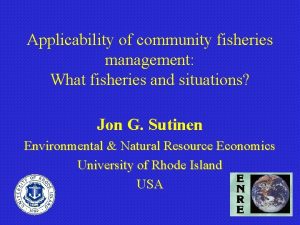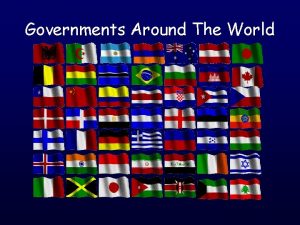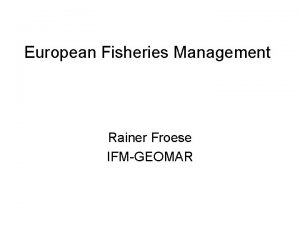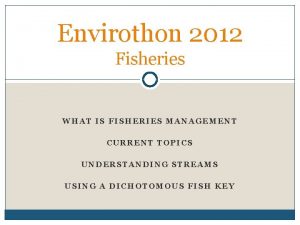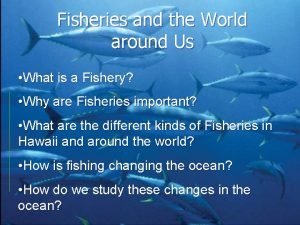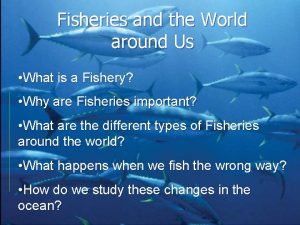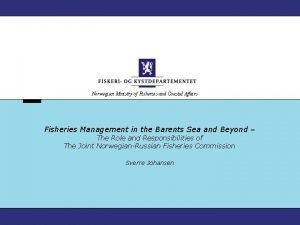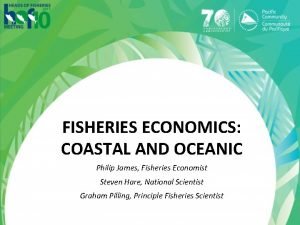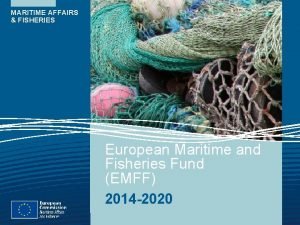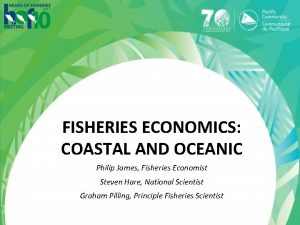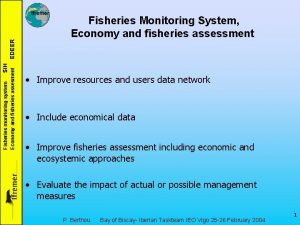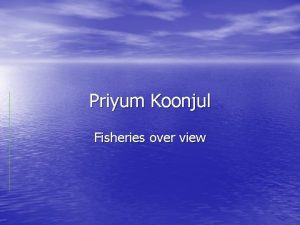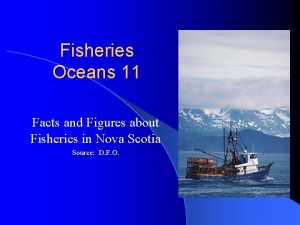Fisheries management around the world elements and implementation






















































- Slides: 54

Fisheries management around the world: elements and implementation Ray Hilborn School of Aquatic and Fishery Sciences University of Washington

Elements of a fishery • A population being exploited • A fishery, people and fleets • A management system

The fish population • The biology of the fish and their productivity – Natural mortality – Recruitment – Growth • The ecosystem – predators, competitors and prey • Physical Environment – Forcing of productivity – Physical habitat structure • Refuge from predators • Habitats conducive to prey • Need for migration – Larval transport

The Fishery • Harvesting fleets, subsistence, commercial recreational – Motivation – commercial profit • Processing • Markets – Commercial fisheries must have markets – Price sensitivity, need for stability

The Management System • Legal Framework – What laws govern the management of the fishery – In the U. S. Federal fisheries these are usually the Magnuson-Steven Act, the Marine Mammal Protection Act, the Clean Water Act, the Endangered Species Act, National Environmental Policy Act – International agreements, Law of the Sea, Stradling stocks agreement, U. N. code of conduct for responsible fishing

The management system • Data collection and research – Catch data – Index of abundance • Surveys • CPUE – – Size and age distribution Tagging studies – movement and stock structure Genetics for stock structure Basic biology of fish, growth, maturation etc

The management system • Regulatory structure – Access – who can fish – The assessment process: how you go from data to best science • Reference points • Harvest strategies – Setting time area, catch limits

The management system • Funding – How much money is allocated to management – Who decides how much – Where does the money come from

The management system • Monitoring Compliance Surveillance – How to assure that regulatory limits are being enforced • • Paper trails Log books Port sampling Observers – human and otherwise VMS – satellite monitoring of vessels On-water observation by air or water Under-cover enforcement

Types of management systems • Totally top down – Government runs everything • Consultative – Top down with extensive input from stakeholders • Co-management – Various shared responsibilities • Devolved – Most activities done by users

Roles in fisheries management Activity Managers Scientists Users Public NGO Goals Always Little Always Mostly Harvest strategy Always Usually Little Data collection Always From Little much to little Little Assessment none Always Same same Access Always Little Same same Setting regulations Always unless devolved Little Same same Enforcement Always unless devolved little Same same Funding none None some Mostly rarely Mostly

Status of fish stocks • Trends in abundance • Stock size relative to MSY target • Fishing mortality rate relative to MSY targt

Trends in abundance

Trends in biomass


Trends in fishing mortality

US West Coast European Union US East Coast Russia/Japan


Fishing Pressure Maximum Sustainable Yield Stock Size

Stock Size below target level S Stock Size above target level

Fishing Pressure Overfished and overfishing Over fished Overfishing Fully Exploited Stock Size Under exploited

Fishing Pressure Current and Future Problem Current Problem – Better Future Possible Future Problem Okay Stock Size Okay

Most recent update of RAM Legacy




Distribution of stock size in FAO catch database

Impact of average catch on status Log 10 average catch

How to measure sustainability • • Abundance Fishing Pressure Trends The fisheries management system

Country-level fishery governance survey • 28 countries • 10 species per country (semi-randomized) • 46 questions among 5 dimensions: … … Socioeconomic s … … Stock status … … Species 8 Species 7 Species 6 Species 5 Species 4 1 1 0. 5 0 1 0. 5 1 1 0. 5 NA 0. 5 0 Confidence level Enforcement 1 1 Species 10 … … Species 9 Management Species 3 … … Species 2 Research Species 1 Country X 0 0 NA NA A B

Research Management • landings data • objectives and fishery management plan • body size or age data • regulations to limit fishing pressure • surveys to monitor trends in abundance • capacity to adjust regulations and fishing • stock assessments Enforcement pressure Socioeconomics • dockside monitoring and at-sea observers • controls on access and entry • penalties and compliance • transparency • protection of sensitive habitats • community involvement • discarding and by-catch measures • capacity-enhancing subsidies

Average response by governance dimension n = 191 survey responses

Bristol Bay Salmon Fishery In Alaska

Goals Harvest strategy Maximum yield with owner operator fleet Fixed escapement goal: daily opening and closing of fishery Data collection State agency Assessment Access Stage agency with collaborators 1800 vessel permits and 1000 shore based fishing permits Setting regulations State agencies Enforcement Funding State agencies State

Pollock Fishery In Alaska


Goals Ecosystem management Harvest strategy TAC Cautious exploitation rates Data collection Assessment Federal agency Access Fixed shares to 3 gear groups, each group formed cooperatives with sharing agreements Federal agency with coops doing self enforcement Setting regulations Enforcement Federal agency Funding Federal and fleet shared

Rock Lobster in New Zealand

Goals Harvest strategy Maximum profit through ITQ system and MSY Target CPUE with management strategy Data collection Fishing fleet Assessment Access Quota holders with government supervision ITQ system Setting regulations State agencies Enforcement State agencies Funding Levy’s on quota holders

Geoduck in Puget Sound

Goals MSY and revenue to state Harvest strategy Rotational harvest Data collection State agency Assessment Stage agency Access Setting regulations Auction of annual harvest rights State agencies Enforcement State agencies Funding State from auction revenues

Role of math and statistics • It has traditionally been essential in providing management advice through statistical models • For NZ rock lobster and geoduck it has become relatively unimportant as empirical approaches have replaced statistical ones • Fisheries provided the cutting edge in resource management of applied decision analysis, Bayesian statistics and formal optimization

Conclusions • We generally know how to sustainably manage fisheries • The best approaches differ greatly depending on the objectives, nature of the fishery and biology of the fish • More than one approach is likely viable • Two key issues I would highlight are – Eliminate the race to fish cooperation not competition – Be clear of your objectives

Oxford University Press publication Available in English, Japanese and Chinese

The dynamics of an unregulated fishery • Development of a profitable fishing operation • Expansion of fleet so long as it is profitable – Fixed and variable costs – Stagnation and overcapacity • Movement onto new fishing opportunities

History of the California Current fisheries

Number of trawl vessels in Finnish herring fishery

Where do fishermen go? Tasmanian abalone fishery

Fishing season in halibut fishery

How to incorporate ecosystem aspects • By-catch – Commonly dealt with by gear and area regulations or by-catch quotas • Sensitive habitats – Usually handled by gear/area restrictions (trawl bans on sensitive habitats) • Trophic interactions – Science is immature – Trophic models offer conflicting advice – Requires complex trade-offsq`1 `

How to incorporate and socioeconomic aspects • Primarily done through overall objectives and access agreements – Some countries ignore – usually means aggregation of ownership – Alaska has explicit policy to maintain owneroperators in state fisheries • Harvest regulations, and enforcement may differentially affect different sectors – Observer programs



 Fisheries management
Fisheries management Split institute of oceanography and fisheries
Split institute of oceanography and fisheries Tea directorate
Tea directorate Institute of oceanography and fisheries
Institute of oceanography and fisheries Ministry of food agriculture and fisheries denmark
Ministry of food agriculture and fisheries denmark Allingham v minister of agriculture and fisheries
Allingham v minister of agriculture and fisheries Dg fisheries
Dg fisheries Agriculture fisheries and food authority
Agriculture fisheries and food authority كما تدين تدان english
كما تدين تدان english Goes around comes around meaning
Goes around comes around meaning Mifco logo
Mifco logo Non est factum
Non est factum Certified fisheries professional
Certified fisheries professional Southeast fisheries science center
Southeast fisheries science center Small-scale fisheries
Small-scale fisheries Northwest fisheries
Northwest fisheries Fish harvesting methods
Fish harvesting methods Ocean fisheries
Ocean fisheries Ocean fisheries
Ocean fisheries Ocean fisheries
Ocean fisheries Alaska fisheries development foundation
Alaska fisheries development foundation General fisheries commission for the mediterranean
General fisheries commission for the mediterranean Nmfs org chart
Nmfs org chart Star fisheries
Star fisheries Tiger shark torpedo
Tiger shark torpedo Atlantic fisheries fund
Atlantic fisheries fund Private equity returns and disclosure around the world
Private equity returns and disclosure around the world Individualism and momentum around the world
Individualism and momentum around the world Chapter 29 nationalism around the world answers
Chapter 29 nationalism around the world answers Nationalism and revolution around the world
Nationalism and revolution around the world Nationalism and revolution around the world
Nationalism and revolution around the world Nationalism and revolution around the world
Nationalism and revolution around the world Database system design implementation and management
Database system design implementation and management Database systems design implementation
Database systems design implementation Weird restaurants around the world
Weird restaurants around the world School calendars around the world
School calendars around the world Puppets of the world
Puppets of the world Palm sunday around the world
Palm sunday around the world Madame tussauds around the world
Madame tussauds around the world Unit 2 around the world
Unit 2 around the world Light the candles all around the world
Light the candles all around the world Cinderella around the world pdf
Cinderella around the world pdf Why is it called the shot heard around the world
Why is it called the shot heard around the world Academic life around the world chapter 1
Academic life around the world chapter 1 Around the world eyfs
Around the world eyfs Beauty stories from around the world
Beauty stories from around the world Meeting famous people around the world
Meeting famous people around the world Hobbies around the world
Hobbies around the world Different climates around the world
Different climates around the world Christmas around the world qr quest
Christmas around the world qr quest Tobacco causes _______ of cancer deaths around the world. *
Tobacco causes _______ of cancer deaths around the world. * Foods around the world
Foods around the world First shot around the world
First shot around the world December holidays around the world
December holidays around the world Around the world, the most common residence pattern is
Around the world, the most common residence pattern is
